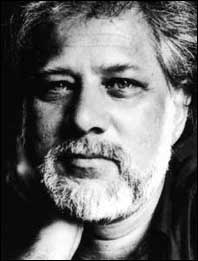"If ever there
was a deus ex machina of our generation it was The Bomb. So how do you evoke that
in a book? I thought about this a lot, actually. I thought about it a lot since I wrote
it, because a lot of people have real problems with that scene. Some people think it's the
essential scene, some people can say it's not. I was trying to convey that a public act
like this does f--- up people utterly. It is what happens to Almasy as well. So, in a way,
it's a kind of parallel story about fate. "
--Ondaatje, Interview
"Hana's alone in male world, that's the
central tension [. . .] She's surrounded by male history, the war, Hiroshima."
--Ondaatje, Interview
Identity
The four main lives of the book--Hana, Caravaggio, The
English Patient (Almásy), and Kip--each have their own story to tell. Their plots
intersect with each other, often without clearly explaining why. Is one story in
particular at the center of the book? Which one?
How does the novel emulate the strengths and
weaknesses of memory?
Do the fragments of the various stories come together
in any holistic way? If so, what is included? What is left out?
How does the shape of the villa reflect the shape of
the characters' lives? (cf. 13,
How are national and ethnic identity played off of in
the novel? How are they called into question? Are they finally denied or reaffirmed? Both?
How does the youth of Kip and Hana compare and
contrast with the old age of the Patient and Caravaggio? (120-123)
Explain how sadness, grief, shellshock, and numbness
express themselves in each character? (e.g. 41, 45)
How is silence an essential element for each
character?
Why, according to Hana, is rest "receiving
without judgment"? (49) Is she correct?
Propinquity (150) implies both near relationship or
kinship, yet also may suggest distance. Propinquity is both touching and not touching, a
space that suggests yet denies, an opening up yet a closing down. How is this essential
paradox at work in the novel? (126-127, 272-273)
Trace the theme of survival in the book.
How do books operate as metaphors and as texts that
foretell and interpret lives in the work? (12, 81, 93ff., 111, 118-119, 144, 233-238, 253,
261)
What is the importance of Hana's marginalia? (61,
209) of the Patient's commonplace book? (16, 95ff., 231)
Why are statues and painting so significant to Kip?
(70-71, 77-80, 116-117, 279-281)
In what ways is Caravaggio a robber? (47-48, 166)
How does Hana respond to being surrounded by men? How
does she view her father? (90-91)
Why do Kip and Hana become lovers? (103-106, 114)
How does Almásy act as a bearer of knowledge? What
is the impact of such knowledge? (e.g. 20ff.)
Characterize Almásy and Katherine's affair.
How is Kip shaped by his experience in England as a
sapper? (187-192, 196-197)
What does Madox teach Almásy about God and war and
identity? (240-243, 247, 250)
Why does the bombing of Hiroshima have such an impact
on Kip? (282-287) What his view of what he was doing as a sapper?
Body
What roles do the body play in The English Patient?
Look at the following passages:
The burned body of The English Patient
Hana's daily bodily routines (e.g. 23, 92)
The loss of Caravaggio's thumbs
Caravaggio' stealing of the film (36ff.)
The cutting of Hana's hair (49-52)
Hana's playing the piano (62-64)
Kip's bodily awareness (75)
Hana's loss of a child [abortion?] (81-85)
Kip and Hana's love (e.g. 128ff., 218, 225-227,
270-271)
Almásy and Katherine's treatment of each other's
bodies (152-153, 156-157, 162, 170-171, 175)
The yellow chalking of bodies (200)
The way mouths reveal character (219)
"We are communal histories, communal books. We
are not owned or monogamous in our taste or experience" (261, cf.
260-261).
Patrick also dies a burned man (292-293, 296)
Question: What model of personhood is present
in The English Patient? How would a biblical view of personhood evaluate the
novel's?
Impressionism
Ondaatje's style in The English Patient is
impressionistic, offering short vignettes often in present tense, which give the text a
kind of timeless feel. He tends to focus on poetic description of setting and action, his
single sentences or observed objects carrying great metaphoric weight, yet he also tends
to obscure their meaning in mysterious asides. Plot is often out-of-order, moments
suggesting a truth which is only later revealed. His descriptions stress place, the
bodily, and use of color.
Question: How does Ondaatje's style shape or
interact with the novel's themes and concerns?
|
